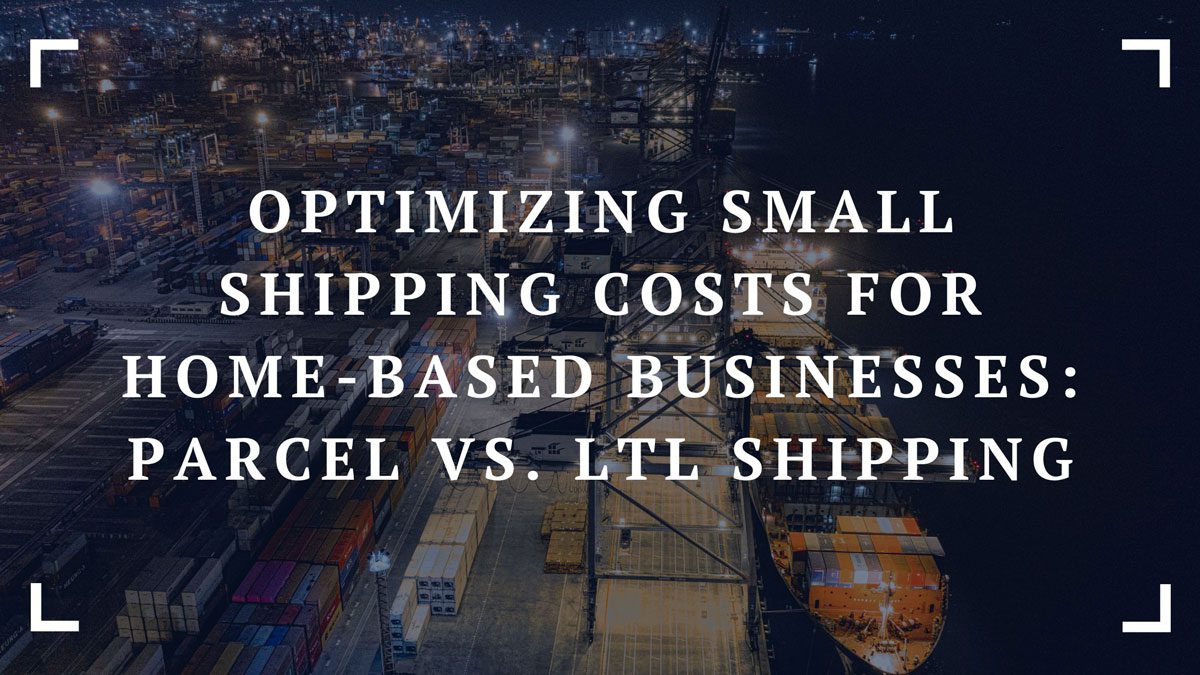Do you have a small shipment, maybe less than a truckload? Are you also looking to save money on shipping costs? Economically transporting small shipments is a priority for many businesses, regardless of their size.
With the rise of home-based businesses and remote work, efficient and cost-effective shipping solutions have become more important than ever. Whether you’re selling handmade crafts, home office supplies, or managing a growing inventory, understanding the nuances of parcel and LTL (less than truckload) shipping can significantly impact your bottom line. In this article, we’ll explore these two popular shipping methods to help you make the best decision for your home business needs.
Some organizations turn to parcel/package shipping, while others look at LTL (less than truckload) methods. Both can be economical for small shipments, but which is the best option for your business? We’ll take a look at both shipping methods so you can make the best decision for your business’s bottom line.

Parcel Shipping vs. LTL
There’s a time when parcel shipping may make the most sense for the load, and at other times, LTL may be the better option. Here’s a quick look at what you get with each type of small shipping method.
Parcel Shipping
Parcel shipping is typically the best option when you only have a few boxes weighing under 150 pounds. The boxes are light enough for an individual to lift, without having to use equipment like cranes.
Compared to LTL, you’ll usually pay less for parcel shipping, but don’t automatically go with this option, but there are a few downsides to keep in mind. Your packages will go through more checkpoints and transfers, and this can result in issues like delayed shipments.
Thankfully, this method does use a robust tracking system, so your packages are rarely lost. You also get a bit of flexibility with delivery. Often, you can skip delivery charges and pick up the shipment at the carrier’s office.
So, when should you go with parcel shipping? If your packages are lightweight (under 150 lbs.), you want to track every step of your shipment’s progress and need some flexibility with the delivery, then parcel shipping may be the way to go.
Parcel Shipping for Home Entrepreneurs:
For small home businesses dealing with lightweight products like handcrafted items, small gadgets, or office supplies, parcel shipping is often the most practical option. It’s not just about the cost; it’s also about the convenience of handling and managing these shipments from a home workspace. Plus, the detailed tracking systems of parcel shipping are a boon for ensuring customer satisfaction.
LTL Shipping
When you’re shipping bulky or oddly-shaped packages weighing over 150 lbs, LTL is often the preferred option. Since the packages are larger, you deal with fewer checkpoints. This can shorten delivery times but don’t wait until the last minute to send your packages out. Delays can still pop up.
Using LTL shipping often means all of the packages arrive at the same time, which is an advantage when multiple packages are going to the same address. Pallets are typically used to secure the packages, which also reduces the chances of one or more boxes getting temporarily separated from the shipment.
A downside to LTL shipping involves the number of checkpoints; since there are fewer checkpoints, it’s a little harder to track the shipment. However, this can also be an advantage as fewer checkpoints also means your packages are being handled less frequently, and this can minimize the risk of damage.
LTL Shipping for Expanding Home Operations
As your home business grows, you might find yourself dealing with larger or bulkier orders. In such cases, LTL shipping becomes a valuable option. Imagine you’re crafting furniture or large artwork; LTL shipping can be more cost-effective and less stressful, ensuring all pieces of an order arrive together and in good condition
So, is LTL the best option? If you’re shipping more than five packages, LTL is often more cost-effective than parcel shipping.
Additional Tips for Home Business Shipping
- Organizing Your Shipping Process: A well-organized shipping area, even if it’s just a corner of your home office, can streamline the packing and shipping process.
- Negotiating with Carriers: For regular shipments, discuss your needs with carriers. Some offer special rates or pick-up services for frequent shippers.
- Using Shipping Calculators: Online tools can help you compare costs between parcel and LTL shipping, letting you make more informed decisions based on the size and frequency of your shipments.
Keeping Shipping Costs to a Minimum
Not every business has an efficient shipping process in place for the goods they need to move around, and some even rely solely on third-party vendors. There’s nothing wrong with using a shipping service, it can even save costs. However, your savings depend on the method you choose.
For small, lightweight packages, parcel shipping is often the best option. If you’re sending multiple parcels to the same location, you may want to look into LTL shipping.
Conclusion
As a home-based entrepreneur, the right shipping method not only saves costs but also enhances your operational efficiency. By choosing the most suitable option between parcel and LTL shipping, you can focus more on growing your business and less on logistical challenges.


